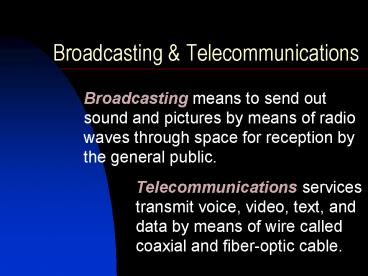Broadcasting - PowerPoint PPT Presentation
1 / 12
Title:
Broadcasting
Description:
Broadcasting means to send out sound and pictures by means of radio waves ... Cartoon Network. Cable News Network. Turner Network Television. How Cable TV Works ... – PowerPoint PPT presentation
Number of Views:641
Avg rating:3.0/5.0
Title: Broadcasting
1
Broadcasting Telecommunications
Broadcasting means to send out sound and pictures
by means of radio waves through space for
reception by the general public.
Telecommunications services transmit voice,
video, text, and data by means of wire called
coaxial and fiber-optic cable.
2
Why is it important to know these two terms ?
- Students of broadcasting need to know something
about nonbroadcast telecommunications because
most electronic mass media depend heavily on
other telecommunications services. - Network television (CBS) utilizes relay
facilities to broadcast their signal to
widespread audiences.
3
History of Broadcasting
- It evolved from prior technologies such as the
telegraph, the telephone, and wireless radio - The verb to broadcast was adopted to express this
edea of scattered dissemination. It comes from
the farmers way of handsowing grain by casting
it broadly, letting seeds fall where they may.
4
It started in the early 1900s
The first radio broadcast stations began regular
operations around 1920.
Television broadcasting began in 1948, following
a hiatus in development imposed by World War II.
5
Networks Dominated
- For nearly 50 years, the three leading national
networks (NBC, CBS, and ABC) dominated
broadcastingfirst in radio, then in both radio
and television. - In 1952, the introduction of UHF television
stations, inherently inferior in coverage to VHF
stations, started independent competition against
the national networks in broadcasting.
6
Columbia Broadcasting System
American Brodcasting System
National Broadcasting System
7
We should note that in 1987, the Fox Network was
launched. Fox was the first of three new networks
to appear on the scene to try to compete with the
"big three" CBS, NBC, and ABC. In 1995, United
Paramount Network (UPN) and the Warner Brothers
Network (WB) were launched. In the case of both
WB and UPN, the main objective was to have TV
station outlets for the material their associated
film studios produced. Thus far, although both WB
and UPN have had successful shows, neither has
had the success of the other four networks.
8
Cable Television
Soon after mass television broadcasting began,
cable television started around 1950.
In 1976, an ordinary UFH broadcast station in
Atlanta, GA, attained superstation status by
arranging for satellite distribution of its
programming throughout the United States. Its
name WTBS now simply known as TBS.
9
Turner Broadcasting System
Turner Broadcasting Also Owns these
Cartoon Network
Cable News Network
Turner Network Television
10
How Cable TV Works
The control center of a cable television system,
the headend, receives incoming signals from
satellites, television antennas and locally
produced programs. From there it amplifies,
converts, and transmits the signals through cable
lines to subscribers.
Cable companies use coaxial lines and even fiber
optic lines to move their signals. Although
fiber optic lines cost more to use.
11
Most cable signals are still sent to homes by
coaxial cable. On the right you can see a
standard coax connector and (to the left of it) a
cutaway view of the single copper wire inside.
Note the central wire is surrounded by a white
electrical insulator. This in turn is surrounded
by braided wire and metal foil shielding. This
shielding serves to both confine the internal
signal to the cable, and keep external RF (Radio
Frequency) energy from nearby appliances from
interfering with the signal.
You often see coax cables and their amplifiers
attached to utility poles.
12
Broadcasting
- Trinity Catholic
- High School

